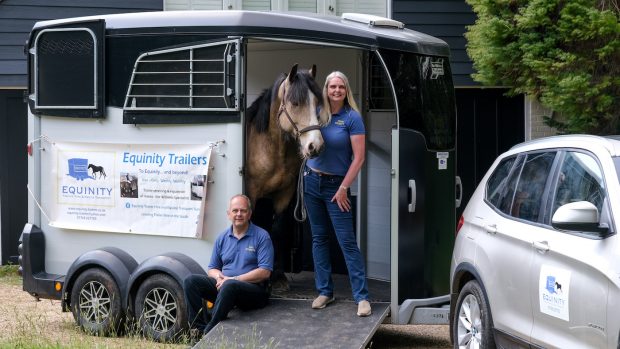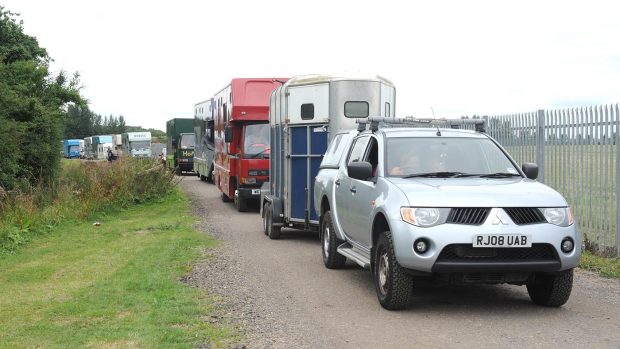In the space of one week, it is not beyond the realms of possibility to see dazzling sunshine, flash floods, patches of ice and even snow flurries, and the key to safe and successful winter towing lies in driver preparation.
There are three main points to address when towing trailers at this time of year:
- Are you confident you can drive safely in adverse weather conditions?
- Are your vehicles in tip-top condition and prepared for every motoring eventuality?
- Do you have plans and procedures in place in the event of an emergency?
Jon Phillips of the Organisation of Horsebox and Trailer Owners (OHTO) believes we can all learn the skills of safe driving in adverse weather conditions, and has some invaluable tips for trouble-free towing.
“Although the driving conditions can be a bit trickier at this time of year, using your car and trailer can be safe if you follow a few common-sense safety tips,” says Jon.
As road surfaces become wet, vehicle traction decreases by about half — and on ice-covered roads, traction can be almost nil. Jon has the following advice:
- Avoid abrupt manoeuvres – drive smoothly and steadily
- If your towing vehicle has anti-lock brakes, use continual pressure; don’t ‘lift up’ when these brakes pulsate
- While applying brakes, use a light and even pedal pressure. This light application should still let the wheels roll, so you can maintain control
- Slow down well before entering a curve. If the curve is a constant radius, keep your speed steady through the turn. Tight turns of decreasing-radius require that you slow down as you proceed; these are the trickiest. Turns of increasing-radius allow you to accelerate lightly as you exit them
Slippery surfaces
Ice can form on roads when the outside air temperature reaches 6?C or lower, so Jon recommends that motorists be prepared for icy conditions at any time.
“An important place to watch for this condition is on bridges — these surfaces are exposed to the wind and cool off faster than the rest of the road,” he explains. “You should also prepare for icy conditions on roads through shaded areas, where a cold wind can freeze a wet road surface.”
Black ice is another common hazard, created when water freezes on dark Tarmac. It usually forms below overpasses, on bridges and in exposed areas.
“Black ice commonly occurs in low, shaded areas and/or when the road surface starts to freeze at night,” explains Jon. “So take heed, and watch your speed.”
The first few minutes of a rain shower can be extra dangerous because of the slippery road surface, caused by oil and rubber build-up. According to Jon, driving is especially hazardous until the surface contaminants wash away.
“Rain may also cause hydroplaning, which occurs when the tyres can’t channel the water away fast enough, causing them to start running on top of the water instead of on the road,” he says. “Traction will be lost, and you must slow down to avoid a skid.”
If you come across flooded roads, drive slowly in a low gear, keeping the engine speed high. Use your lights, windscreen wipers and de-misters in the rain – spray can reduce visibility. Mist and fog is usually found in low places or areas surrounded by trees, hills or mountains, so slow down and turn on your low-beam headlights.
If it is windy do consider how important your journey really is. But if you must venture out, anticipate sudden gusts by looking for signs around you, such as tree movements or blowing leaves and snow.
“The best advice for driving in windy conditions is to slow down,” says Jon. “When passing trucks, move slightly away from them whenever possible to reduce gust effects.”
Avoid getting stuck
If you are driving off-road in wet conditions, the advice is simple – prepare for mud!
“Some soil textures cause a vehicle to sink; others will make the surface like driving on ice,” explains Jon. “Try to keep your vehicle moving slowly and steadily forward in gear. If you feel the wheels start to spin and lose traction, let up on the accelerator slightly. This should allow the wheels to regain traction.
“If you do get stuck, make sure your front wheels are pointed straight ahead and don’t spin the wheels. If this fails, place some type of friction material under the wheels – straw, carpet, stones or anything with a rough surface. It is time to call for help if you can’t free the vehicle with these techniques.”
Jon has one last tip for intrepid travellers – keep your fuel tank at least half-full, as you don’t want to get stranded.
“Another reason for a full tank is that warm daytime temperatures will fill the empty space in the tank with moisture, which will condense during a cold night,” he explains. “This water will sink to the bottom and, sooner or later, rust out your tank or give running problems.”
This feature was first published in HORSE magazine


